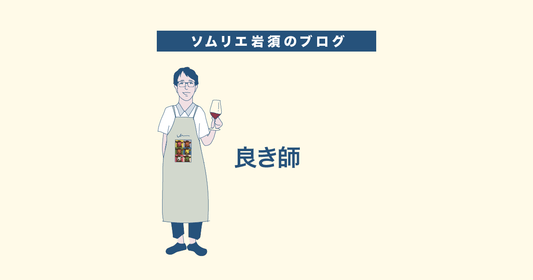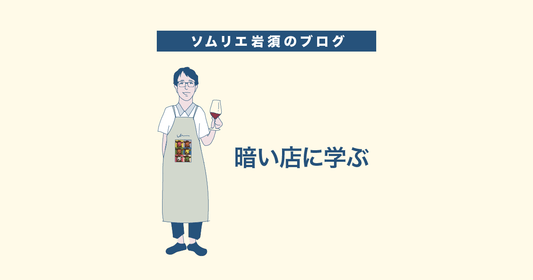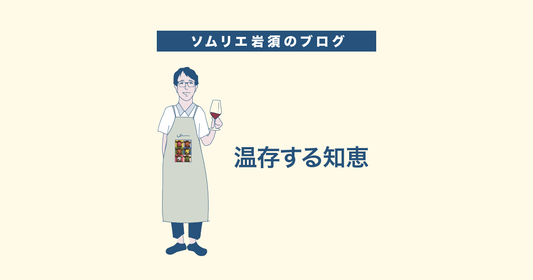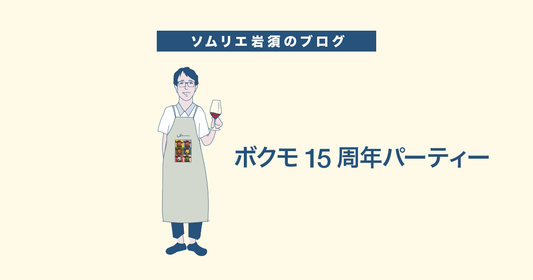
I'm still struggling every day with the coronavirus, but today I received a reservation for a course meal for the first time in a while. What's more, it included a wine seminar. The customer wanted to listen to the sommelier's talk while enjoying the pairing with the food. As someone who likes to talk, this was a very welcome order.
We don't usually have courses like that, but what we should have are customers who say, "I'm sure Iwasu can do this much." Of course, I gladly accepted. I'm really grateful.
However, at this time, there are some things we need to think about.
First, there is the issue of distance. This time, we are having a course meal for 10 people. Ideally, we would like to set it up on one long table, but that would mean that the distance between customers would tend to be too close.
So this time, we decided to have everyone sit at three tables that are a little far apart. We also arranged the chairs at each table with a little space between them. For now, this is the setting that maintains the maximum distance possible in our restaurant.
However, this makes wine seminars difficult.
The wine seminars I usually hold at Junkudo Bookstore are conducted using a projector and PowerPoint slides (currently suspended). This way, everyone can focus on the talk because they are looking at the screen in front of them. It is also easier for the speaker because everyone is looking at them.
However, this time, the room was divided into three tables, which were arranged in an L-shape. There was a little distance between the tables. Therefore, the direction of the front from each seat was different. Therefore, the projector and PowerPoint could not be used. Hmm. This was a problem.
So, I guess I'll have to give up on attracting everyone's attention and go with the old-fashioned "paper resume method." I'll prepare a pen and have people write down anything that interests them. It's possible that people won't be able to concentrate for long, but that's unavoidable.
Another issue is the voice. Since the seats are far apart, I'm a little worried about whether my voice will be heard. Since I'll be wearing a mask, my voice may be muffled and difficult to hear. From the perspective of droplet care, I can't get too close to the customers.
One option would be to use a microphone from a slightly distant location, but then this would be a nuisance to other customers in the store.
No matter how you look at it, "paper and pen" + "voice through a face guard" is weak. There is a possibility that what you want to say will not be conveyed. If that's the case, I'm sorry that you ordered a course with a seminar at this time.
Hmmmm... Any good ideas? I thought to myself, and went ahead with the seminar.
But then I had an idea!
Oh, I have this blog! I can just summarize the main points and post them on the blog.
If you forget to take notes on your paper resume or can't hear my voice, you can always check out this blog later to review.
Let's do that.
Of course, this blog will be viewed by people other than those who participated in this course. Some customers may feel that it would be unfair to post the contents here, which can be viewed for free.
However, a wine seminar can only be realized if the participants actually try the wine and, in this case, experience pairing it with food. It won't be an experience if it's just written information. Okay, I'll say it like that, and if the participants agree, I'll upload it to the blog.
So, I was able to get approval. Thank you.
From here on, we will share the contents of the pairing seminar held on August 20, 2020.
Wine and food pairing event
2020.8.20 @ Bokumo
"Knowing how to pair food changes the way you enjoy it." This is something I've experienced myself. But first, let me explain a little bit about the word "pairing."
In the past, the word mariage (marriage in French) was often used, but nowadays the word "pairing" is more commonly used to describe the combination of drinks and food.
Perhaps it reflects the current situation in France, where the term originated, where an increasing number of people are choosing common-law marriage over marriage?
Also, I think that in this day and age, the word "pairing," which simply means "simply being a pair," fits well, including the implication that "marriage is not necessarily the best match"...but, well, this is just my personal opinion.
Anyway, today's theme is wine and food pairing. What are the benefits of knowing this?
First, for example, when preparing or choosing a dish, you will be able to think about which wine would go well with it.
Conversely, when buying wine, you will be able to choose the food you will pair it with.
When you do this, your imagination will expand and wine will become like a side dish to the meal. It's so much fun.
It takes a bit of practice, but if you do it repeatedly, you'll be able to fully enjoy the two benefits above.
If you experience how food tastes much better with wine, and how wine tastes even better with food, your way of enjoying food will change completely.
However, Japanese people have a hard time understanding the concept of pairing. For example, pairing sake with snacks. Originally, it seems that people didn't really consider that snacks can make sake taste better, or that pairing sake with snacks can add a new flavor to the snacks.
However, in Europe, people would have one bottle of wine on the table, and would enjoy the wine and the food back and forth, and have conversations like, "This goes well with this food." In other words, for them, wine was like a side dish that was part of their daily meals, like miso soup, which goes well with white rice. We Japanese learned this later, and that is what we call pairing.
Now that you're hungry, without further ado, let's try our first pairing.
The first dish was an appetizer platter called the Bokumo Platter .
Today is
- Tomato basil bruschetta
- Tuna and egg
- Chopped salad of summer vegetables and wheat bran flakes
- Cheddar cheese and dried mango
is.
As such, light appetizers, especially salads, go well with a refreshing white wine or sparkling wine.
Start with an aperitif of Italian Prosecco (sparkling wine), and when you're done, try a glass of New Zealand Sauvignon Blanc. What do you think?
Next up is " New Zealand mussels baked with breadcrumbs," which is paired with New Zealand rose wine.
So, having looked at all of this, what are your thoughts?
Whether it suits you or not depends on your own taste buds. This is just a suggestion, not a perfect one.
However, we can give you some hints on how to make it easier to understand whether something is a ``yes'' or a ``no.''
Here's how it works.
First you put the food in your mouth, chew it, swallow it, and then right after that, take a sip of wine.
This is important.
While the aftertaste of the food is still in your mouth, take a sip of wine.
If you feel that "The aftertaste of the food is even more fulfilling and delicious!" or "The wine tastes better when drunk immediately after the meal than when drunk on its own!" then the pairing is a success.
"Not that great." It's a mediocre pairing.
"It ended up being worse." This is a bad pairing.
See? It's very simple, right? Pair the wine with the aftertaste of the food. If you follow this rule, you can then use your own sense to decide whether it goes well with the food or not.
Next up is "Penne in Tomato Sauce," a pasta dish that I chose because I thought it would go perfectly with red wine.
This pasta has a not too strong tomato sauce, so it would go well with a wine that is not too strong.
Yes, matching the strength of the flavor of the food and the strength of the wine often makes a good pairing.
Pair it with a New Zealand Pinot Noir.
So, what do you think? I think everyone is satisfied with this pairing. I think that the red wine gives a fuller aftertaste, which is the secret of the pairing, than the white wine.
Now, let me tell you about another interesting technique for making pairings successful.
It's a technique to think of wine as a "dressing" or "sauce."
As mentioned earlier, wine is a drink that can have a pairing effect when sipped immediately after eating food.
In other words, you could say that "wine puts the finishing touches on the dish in your mouth." In other words, wine plays a role similar to the dressing sprinkled on top of a finished dish, or the sauce added at the end.
If you keep this way of thinking in mind, for example, when you drink a wine by itself, you can let your imagination run wild and ask yourself, "What kind of dressing would this wine make?" or "What kind of sauce would it make?" From there, you can come up with the perfect dish to pair with it.
With that in mind, let's move on to the last dish.
The last dish is "W Rosso Braised Spare Ribs." W Rosso is a term I coined, meaning that the dish is braised using "double red," that is, "red wine" and "red miso."
What do you think? The combination of tender stewed spare ribs and a rich sauce made from red wine and red miso is delicious, isn't it? It's one of my favorite dishes.
This is paired with a New Zealand Merlot and Cabernet Sauvignon blend, which has a rich, astringent flavor similar to red wine from Bordeaux, France.
This combination is good, isn't it? A meat dish with a long aftertaste and a red wine to go with it. After all, the dish contains red wine, so if you choose a strong red wine to match it, it will definitely be a good pairing.
Finally, here's one more pairing tip.
It's good to think of wine as a dressing or sauce. I think you can understand that much. However, when you actually try the wine, some of you may find it difficult to imagine specifically what kind of dressing or sauce it is.
When that happens, think about it this way.
From the dozens, or even hundreds, of complex elements contained in wine, "extract the keywords that resonate with you the most."
To put it more boldly, "Try to picture one fruit that you sense in the wine."
Then you imagine sprinkling a dressing or sauce made from that fruit onto a dish.
For example, among the wines we're having today, the white wine, New Zealand Sauvignon Blanc, tastes like grapefruit to me, so I think, "Okay, I'll use this wine as a grapefruit dressing."
So, I can imagine that grapefruit dressing would go well with the "summer vegetable salad" that I served today. It would also be good with "red sea bream carpaccio" and "pork shabu salad."
I feel that the red wine I served at the end contains an element of "cassis". So, the food that goes well with cassis sauce is "slowly stewed meat dishes". "Grilled meat" and "aged cheese" would also be good.
Of course, the world of pairing is not just this, and there are probably many more complicated factors involved. There may be some great pairs that cannot be explained by this method.
However, I believe that if you are first thinking about connecting food and wine, this kind of simple idea will make it easy to do so.
Let me recap once more:
- "Imagine the fruit you feel in the wine."
- Replace this with "dressing" or "sauce" and imagine the dish.
With this repetitive practice, pairing becomes more and more fun.
If possible, it's a good idea to buy a few bottles of your favorite wine and remember the taste of the wine. If you find fruit while drinking it, go to the supermarket on your next day off. While you're in the supermarket, think about what dish would go well with that fruit dressing or sauce. "Oh, there's a special sale on octopus from Hokkaido! This might go well with grapefruit dressing (= New Zealand Sauvignon Blanc)!" If you do that, I'm sure cooking will become much more fun.
In fact, when I think of pairings for my restaurant, I often first imagine the wine as a dressing or sauce, then sprinkle it on the food. It works quite well.
So what do you think? Are you a little more interested in pairing? I hope today has inspired you to think about pairing.
Ah, everyone is getting drunk by now. Some people have rosy faces, some red faces, and it looks like they're having fun. Now it's time for some social time. Please take your time.
The seminar was like this.
Actually, in the actual seminar, we also talked about other topics such as "pairing tricks" and "common misunderstandings," but I guess those were special topics for those who attended.
If you attended the event but have forgotten what was said, please contact us and we will repeat it for you at any time.
So, this time I have summarized the contents of the "course meal with pairing class held at Bokumo". The price is 5,000 yen per person including tax. If you are interested, please feel free to contact us. (I ended up advertising! Sorry, it's a difficult time!)





